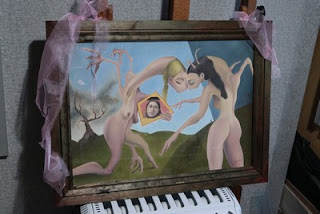A 25 hour day - joy! I can fill one more hour. I started by photographing the Sleep and 'Castle for the King of Death' paintings. This is a complex, physical job. I need to assemble a heavy wood base plate, the lights with 6 bulbs, two power extensions, and the wooden legs; then two tripods with aluminium rails, and fit the camera lens and plates; then calibrate the camera and align all materials. The process took almost all morning, including digital montage and taking everything down again and filing it away. The final image still looks poor compared to the actual painting, but this is always the way.
I keep thinking how to make it faster. I could do with money for more electrical wire to integrate the 6 lights. At the moment only 4 are integrated with 2 needing fitting each time. I could leave all 6 bulbs fitted, though they would be liable to get dusty. Setting up the tripods and rails takes time too, and the calibration. Ideally, these legs would be, or could be, fitted at exact right angles to the heavy wooden bed.
In the afternoon, work on the Rachel Hudson frame. It would be intolerably boring to simply frame this; it must look like a total artwork. I started by roughing up various areas of the frame with a wire brush, to make it look bruised and injured, then painting in the raw parts with dark wood stain. Then red stain to splatter it in various places. The results were remarkably pretty, perhaps even prettier and ironically smoother than before I'd started, as the sharp corner joints were now hidden.
Then, I rusted some nails with hot salt water and hydrogen peroxide. This fizzes iron into rusty iron in seconds. I tore some pink organza material and placed it around the edge, then nailed it into place. The organza was purchased for the 'Except For The Hatred' painting, and and nail rusting was a trick from the Hanged Rolf Harris painting.
Then I decided to write some text onto the frame. I had thought about adding more of the 'Sing a Song of Sixpence' rhyme, but I also thought that I needed to add something about Rachel herself, so I simply added her name and dates of birth and death as a tribute. I experimented with how best to do this. I wanted a scratched look, and initially thought of simply scribing the letters as I did with the 'Financial Circumstances' frame - I took a look at that to see how it looked. I decided to do a test, and got out my old (and much in need of replacing) soldering iron and burned some letters into some similarly stained wood. These looked much better. I'd used pyrography for the old Janet Frame picture. I also liked the idea that pyrography was included, yet more gamut to the methods employed, along with oil painting, woodwork, cloth and rusty nail chemistry!

Finally, the painting was framed with some Perspex. I've used 2 of 3 Perspex panes I have. Sigh, I'm running out of supplies and have no money for more. I need to sell more. Cutting the Perspex was as horrid as ever. Unless I can find a tiny circular saw (one which doesn't get hot) I must simply cope with the danger and exertion of a craft knife.
So, a full day complete. I need to file and photograph this in its frame, then I'm ready to enter the competition. Deb and I quickly visited the new Crewe Art Space yesterday, perhaps this would be a good venue to show this in some sort of presentation. My original local art space was The Cubby Hole. Many of my early exhibitions were held there, and Carol was so supportive and helpful.



















